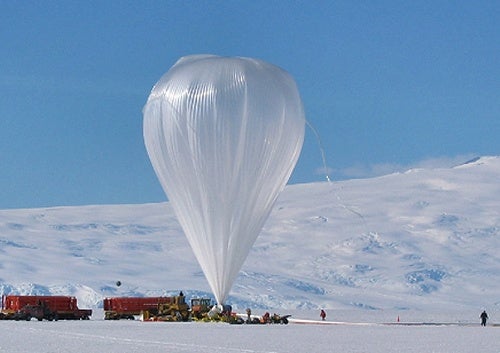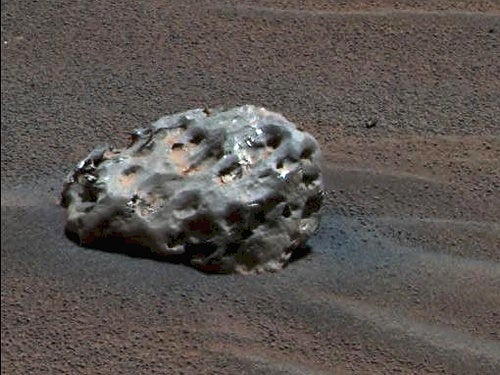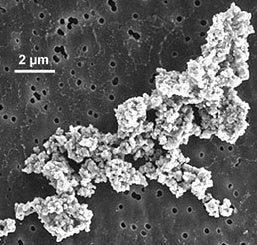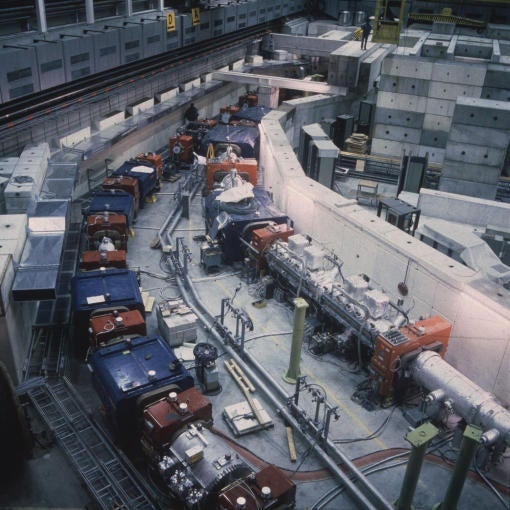CREAM of the crop
The balloon-borne Cosmic Ray Energetics And Mass (CREAM) instrument has set a record for flight duration and distance, circling the South Pole 3 times during its 41-day, 22-hour flight above Antarctica. The pilot-less, helium-filled balloon is made of polyethylene film about the thickness of sandwich wrap — and longer than a football field — and demonstrated NASA’s Ultra-Long Duration Balloon (UDLB) support system.
CREAM was airborne December 9 to January 27. The device is designed to explore how fast supernovae accelerate cosmic rays — protons, electrons, and heavy nuclei from beyond the solar system that slam into Earth’s atmosphere. The balloon — weighing 4,055 pounds (1,839 kilograms) itself — lofted the 2-ton package to an altitude of 125,000 feet (38,100 meters), while expanding to a diameter of 450 feet (137m) in the thin air. — Francis Reddy
AAVSO’s new director
Effective March 1, Arne Henden will become director of the American Association of Variable Star Observers (AAVSO), the organization announced today. He succeeds Janet Mattei, who directed the group from 1973 until her death March 22, 2004.
Bill Dillon, AAVSO president, describes Henden as “a perfect fit.” Henden is a senior research scientist for the Universities Space Research Association at the United States Naval Observatory in Flagstaff, Arizona. Henden’s research interests include optical and near-infrared imaging, variable stars, gamma-ray-burst afterglows, and collaborations between amateur and professional astronomers.
AAVSO is an international, nonprofit, scientific organization based in Cambridge, Massachusetts. It coordinates, compiles, digitizes, and disseminates observations of variable stars to researchers, educators, and students worldwide. — Francis Reddy
Mars Exploration Rover scientists and engineers have renamed the nickel-iron meteorite recently found by Opportunity on Mars’ Meridiani Planum. The meteorite was originally dubbed Heat Shield rock because it was found near the crashed remains of the rover’s discarded heat shield. Now, the dimpled and puckered meteorite is being called SpongeBob, after the famous cartoon character.
Opportunity has left the heat-shield crash site and is driving south-southwest toward the first of a series of small craters. The rover will examine these on the way to its next major target, a mesa (or partly buried crater) dubbed Vostok, which lies about a mile away. — Robert Burnham
David Lunt (1942-2005)
David Lunt, creator of Coronado Technology Group, died on January 16 after a long battle with cancer.
Born to professional opera singers in Denbigh, Wales, Lunt’s parents passed away while he was in his teens. He studied astronomy at Harvard University on a full scholarship. He left the university early in order to work and support his siblings. During his career, Lunt helped develop the mirror for NASA’s first Orbiting Solar Observatory and was a consultant for the Strategic Defense Initiative, a proposal to use space-based systems to protect the United States from a nuclear missile attack.
In 1997, Lunt founded Coronado and created a line of hydrogen-alpha solar filters. Unlike those before, this line was more affordable and designed for smaller scopes. The filters and subsequent products earned the respect of the amateur astronomy community.
Meade Instruments acquired Coronado in October 2004. — Jeremy McGovern
Dusty secret revealed
A team led by John Bradley of Lawrence Livermore National Laboratory in Livermore, California, reports it has identified a mysterious ultraviolet signal long seen in the spectra of interstellar dust.
Interplanetary dust particles plucked from Earth’s stratosphere are complex collections of primitive grains, some of which represent samples of the interstellar matter that formed the Sun and planets. When Bradley’s group studied these particles under a transmission electron microscope, it found tiny carbon and silicate grains embedded within these particles, according to a report in this week’s Science. These grains, which may form when UV light shines on interstellar dust, are the likely source of the ultraviolet bump.
“Our findings suggest that organic carbonaceous matter and silicates, the ‘common stuff’ of interstellar space, may be responsible for the 2,175 Å feature,” says Bradley. The properties of these grains may help explain how interstellar organic matter made its way into the solar system and will form the basis of new computer models and laboratory measurements. — Francis Reddy
Orion Telescopes & Binoculars sold
Imaginova, the operator of Space.com, has acquired Orion Telescopes & Binoculars. Orion, of Watsonville, California, sells its broad line of instruments and accessories through its catalog, website, and specialty retailers.
In addition to the Space.com web site, Imaginova, of New York City, produces LiveScience.com, the Space News trade publishing business, and the Starry Night astronomy software and DVD brand.
Deep Impact on its way
This morning, NASA launched its Deep Impact mission. The twin spacecraft is on a one-way, 6-month journey to smack into Comet Tempel 1. The goal is to obtain a never-before-seen internal view of a comet.
Deep Impact is comprised of a spacecraft that will observe the comet and a impact probe that will excavate the surface of Tempel 1’s icy nucleus. — Jeremy McGovern
Quivering planet
According to NASA scientists, the magnitude 9.0 earthquake that launched a destructive tsunami throughout the Indian Ocean rattled Earth itself, slightly altering its shape and rotation. The net effect is a slightly more compact, faster spinning Earth.
The Indonesian quake occurred at the Sunda trench, where the India and Burma tectonic plates meet. It’s here that the India plate slides beneath the Burma plate and begins its plunge into Earth’s mantle.
At 58m 53s UT December 26, 2004, rock along a 60-mile (100 kilometer) stretch of the trench fractured, causing about 740 miles (1,200 km) of the plate’s boundary to slip an average of about 50 feet (15 meters), according to a preliminary analysis by the U.S. Geological Survey. This motion lifted the ocean floor immediately above the fault by several meters, triggering a tsunami that raced across the Indian Ocean. The waves killed people as far away as the east coast of Africa; the death toll now stands at more than 150,000.
Richard Gross of NASA’s Jet Propulsion Laboratory in Pasadena, California, and Benjamin Fong Chao, of NASA’s Goddard Space Flight Center, Greenbelt, Maryland, calculate the quake narrowed Earth’s equatorial bulge by about 1 part in 10 billion. This, in turn, makes the length of the day about 2.68 microseconds shorter and shifts the “mean North Pole” about 1 inch (2.54 centimeter) toward longitude 145° East.
The change in the length of the day is probably too small to detect, say the researchers, but data from ground-based and space-borne position sensors may reveal the change in Earth’s figure. — Francis Reddy
National Dark-Sky Day petition
Ken Rank of HillTop Designs, a screen-printing company in central Kentucky, has created an on-line petition asking the United States Congress and President Bush to establish a National Dark-Sky Day. The goal is one day set aside each year giving educators and astronomers a chance to share the wonders of the night sky, while bringing awareness to the growing issue of light pollution.
In addition to this effort, Rank also donates 20 percent of profits from HillTop Designs to the International Dark-Sky Association. Click here to sign the petition or view signatures.
— Jeremy McGovern
Understanding the tsunami disaster
The Canadian Space Agency (CSA) is leading an effort to coordinate space-based images of the devastating aftermath of the December 26 Indian Ocean tsunami. Following a provision in the international charter “Space and Major Disasters,” the CSA will head an international coalition that includes the European Space Agency and the U.S. National Oceanic and Atmospheric Administration. Images and data collected from various satellites — such as RADARSAT, IRS, SPOT, LANDSAT, and ENVISAT — will help scientists evaluate the disaster’s impact.
The international charter created a cohesive system of space-data acquisition and delivery to those affected by disasters. Each coalition member provides resources to support the provisions of the charter. View the web site here. — Jeremy McGovern
Neutrino superfluids?
When a collection of particles coalesces into a single quantum state, the result is called a superfluid. Many particles can behave as a superfluid under the right conditions. For example, physicists expect that neutrons in the crust of a neutron star exhibit this property.
Now, Joe Kapusta, a physicist at the University of Minnesota, has published a proof in the December 17, 2004, issue of Physical Review Letters showing that neutrinos can form superfluids, too. “Although such a superfluid could conceivably exist,” says Kapusta, “detecting it would be a major challenge.” One reason: The superfluid occurs only at temperatures far colder than the average temperature of the current universe (2.7 kelvins). — Francis Reddy
Although it sounds like science fiction, physicists routinely make atoms of anti-hydrogen at the CERN laboratory in Geneva. Now, physicists report what may be the coldest anti-atoms ever created in a lab.
Harvard University physicist C. H. Storry and other members of the ATRAP collaboration report a step toward this goal in the December 31, 2004, issue of Physical Review Letters. For the first time, they used lasers to improve control over the production of anti-H. A laser excites cesium atoms into specific states, then positrons — anti-electrons — collide with the atoms. Each cesium atom relinquishes one electron to a colliding positron. The electron-positron pairs, which form an atom-like entity known as positronium, inherit the excitation of the original cesium atoms. Occasionally, the positron component will latch onto a passing anti-proton, forming anti-H with the same level of excitation as the positronium.
Although the laser makes less anti-hydrogen than other methods, the control it offers over conditions within the trap will be useful in future experiments. — Francis Reddy













